
Quick Slant: SNF - The Comings and Goings of Winning Culture
Mat Irby’s Quick Slant
Los Angeles still glows after the Dodgers renewed their championship banner subscription last Saturday; not only so, they own the rights to the greatest baseball player who has ever lived, and they participate in a sport without a salary cap, where the richest and most willing are rewarded for being rich and willing—and no one is richer and more willing save for maybe the Yankees.
The Lakers continue to celebrate their grand larceny of one of the great basketball players of a generation—a heist that would make the security team at the Louvre wince. The Lake Show is off to another hot start, and a new generation of championship-caliber all-stars in purple and yellow has already sprung up like a lizard’s regenerated tail, replacing the old one before it was even at its end.
And don't look now, but the Rams are arguably the NFL's best team. Why not? Who says you can't have it all?
Yet, hidden beneath everything, Los Angeles doesn’t seem to know what’s coming.
For those who are paying attention, Jim Harbaugh and the Chargers feel inevitable. It won’t likely be in 2025, but it will happen; they will be contenders soon enough. Harbaugh’s career winning percentage is 66.3%; only Nick Sirianni has a better percentage among head coaches, and each lies just outside of the all-time top ten. When Harbaugh took over, the Chargers were a reeling, desperate operation—always all hat and no cattle, dwelling in the shade of their SoFi Stadium siblings. They collected excuses like commemorative plates and made an art form out of underperformance.
But under Harbaugh, they took the broken pieces that were lying around and made a playoff push in Year One. The priorities began to shift, and the operation took on a more serious tone. Everything began to move toward winning, and winning started to act as a contagion.
L.A. started this season like they were fired from a rocket ship; they could blame their shortcomings ever since on injuries and be justified, but they continue to churn on. That’s what builds a winning culture.
That’s not a training Pittsburgh necessarily needs. The Mike Tomlin Steelers define winning culture with 21 consecutive non-losing seasons. And every time we are ready to count them out, they sprout like an obnoxious weed that won’t go away.
They are led by a QB who lives by the same mantra. Aaron Rodgers’ Jets experiment failed, and conclusions were drawn, but we jumped the gun in reading Last Rites. In the short span of time since Rodgers left for Pittsburgh, we’ve all noticed: the Jets have sunk to the bottom like they have pockets full of stones, while the Steelers—for years, coasting like a car that has run out of gas in motion—have been reinvigorated by Rodgers’ innate ownership of winning culture. Dare we say it? That the Steelers’ head start over the Ravens feels potentially substantial? That they are once again in real contention for a division crown?
The Steelers and Chargers feel like incoming and outgoing empires, meeting at the door. The only question on Sunday is, which one will step aside while the other walks through?
Steelers
Implied Team Total: 21
The Steelers lead the unexpectedly vulnerable AFC North by two games. By Pythagorean expected wins, the Steelers are just above average, on pace for 8.8 wins.
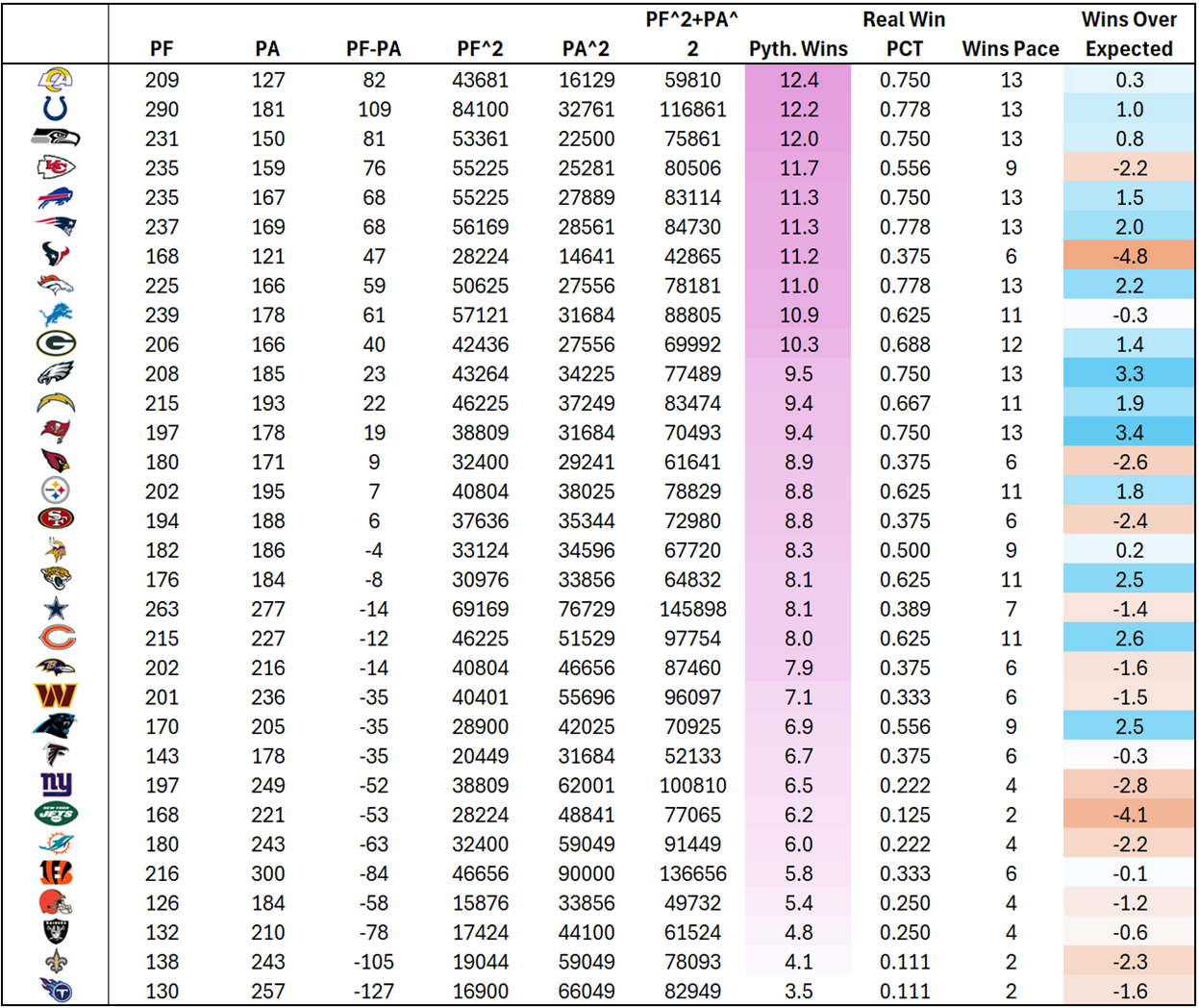
In fantasy football, good fantasy environments often emanate from situations where a team is good at offense and bad at defense. We are not particularly used to the Steelers being either. However, they kind of fit the bill—above average in offensive EPA per play and below average in defensive EPA per play, albeit barely.

The Steelers’ offense ranks 13th in offensive EPA per play and 19th in offensive success rate. They rank 16th in offensive EPA per dropback and 25th in offensive success rate on dropbacks.
Pittsburgh runs a little on the slow side at 27.3 seconds to snap (20th), and they have a 59% pass rate (T-10th). They are even pass-heavy by way of pass rate over expected (PROE)—unexpected with OC Arthur Smith at the controls.
We have a long history of Smith’s patterns, not the least of which includes annually having one of the lowest pass rates in the NFL. Then again, even at this stage of his career, Rodgers is considerably better than most of the QBs Smith has lugged around: Marcus Mariota, late-stage Ryan Tannehill, late-stage Matt Ryan, Desmond Ridder, Taylor Heinicke, late-stage Russell Wilson, and Justin Fields. Rodgers is still above average in EPA and CPOE.
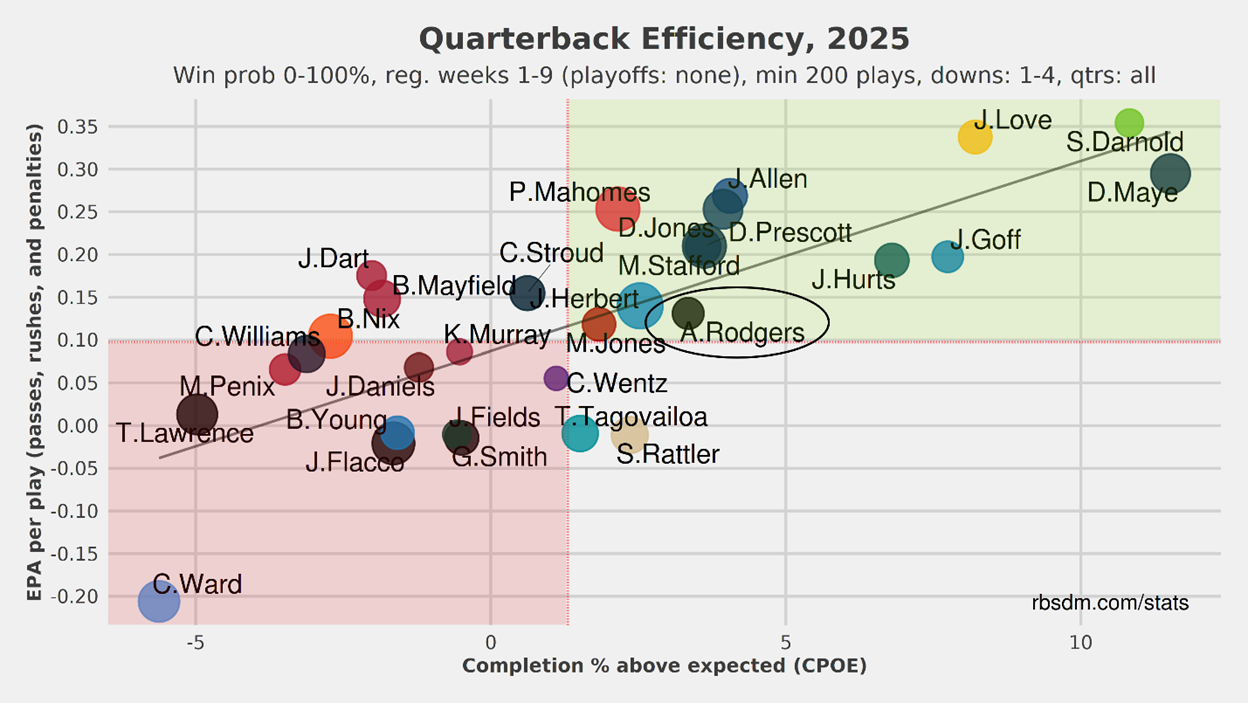
Even still, the Steelers have only 58 offensive snaps per 60 minutes (T-31st), a surprisingly low play count considering the pretext mentioned above. Some of this has to do with the Steelers' defense, as Pittsburgh has an average time of possession of just 27:35 (30th).
As such, Rodgers has only 33.1 dropbacks per game (28th); he has converted those into 30.4 passing attempts per game (21st), a rate of 91.7% (4th) of attempts to dropbacks. This means he generally doesn’t take sacks and doesn’t scramble.
Rodgers once had the slightest bit of juice in his legs, but he’s 41 years old now and should be viewed as entirely immobile (e.g., Jared Goff and Joe Flacco have more rushing yards).
With a nonexistent rushing platform and below-average pass volume, Rodgers is incredibly TD dependent. In fact, he has a significant rate of TDs to passing yards, making him a candidate for negative TD regression against simple base rates.

Rogers has been a QB1 twice this season. In each case, it took a four-TD game to get him barely over the threshold. Otherwise, he has been riding along the back half of the QB2 ranks.

It is not out of the question that Rodgers could maintain this TD rate because he has generally performed above the base rate throughout his career. Since 2010, his career TD rate of 6.1% is just barely lower than his 2025 rate of 6.6%, although Rodgers hasn’t carried a TD rate in this range since 2021, when he finished the season with a 6.5% TD rate.
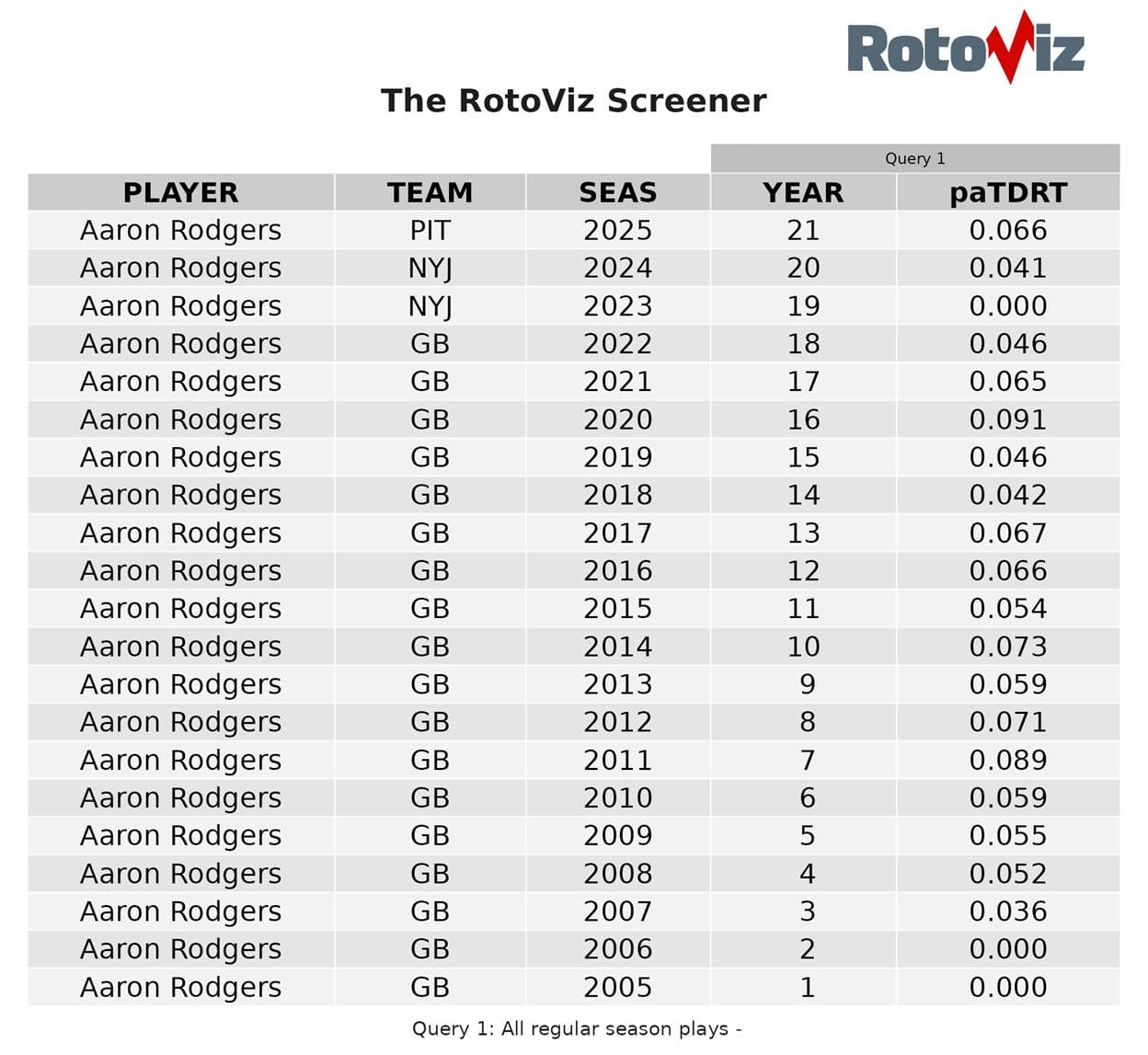
The Chargers rank ninth in defensive EPA per play and fourth in defensive success rate. They rank seventh in defensive EPA per dropback allowed and third in defensive success rate on dropbacks.
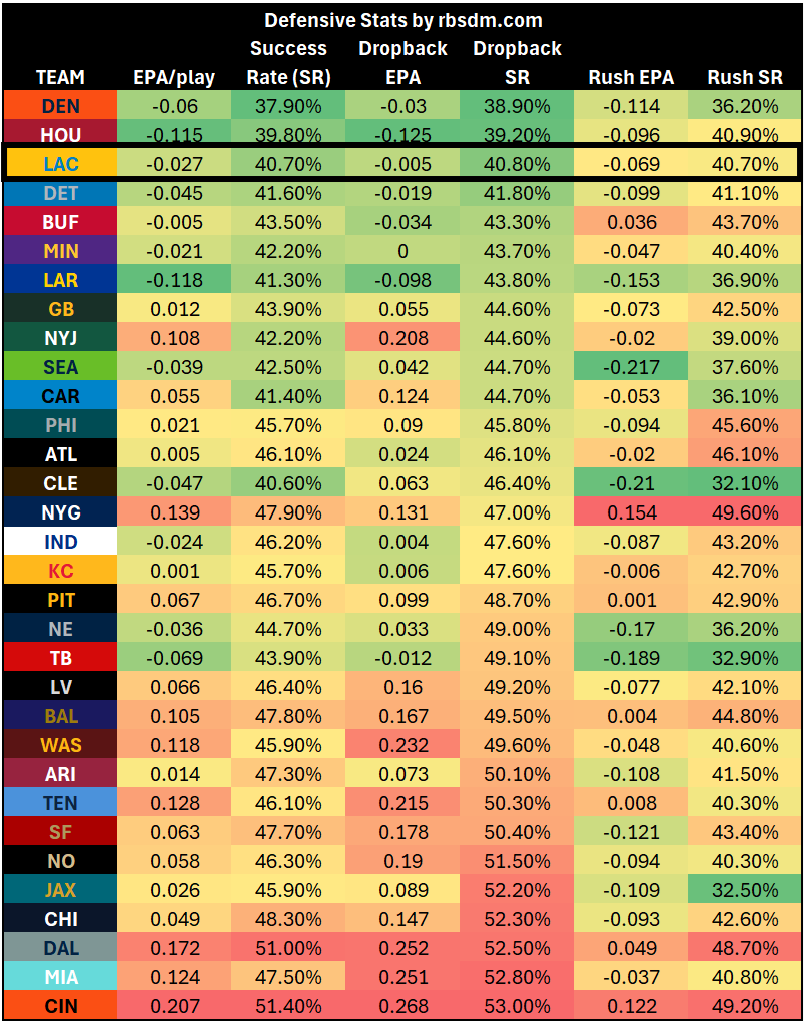
L.A. has been super stingy against fantasy QBs, holding opposing signal callers to 30th in fantasy points among QBs.
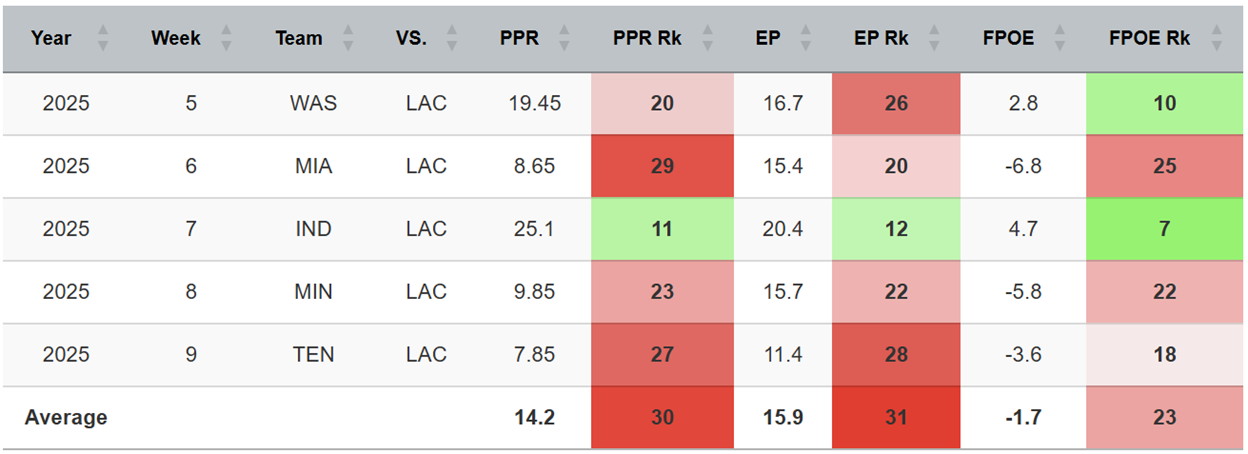
Rodgers feels like a total dart throw this week—a dart that could easily land with once again elevated TD production, but there should be no confidence starting Rodgers.
In their last five games, the Steelers have not had a pass-catcher with more than a 20% target share; WR DK Metcalf is their closest, with a 19.7% share. The only other Pittsburgh pass catcher with better than a 15% share in that time is Calvin Austin (15.1%).
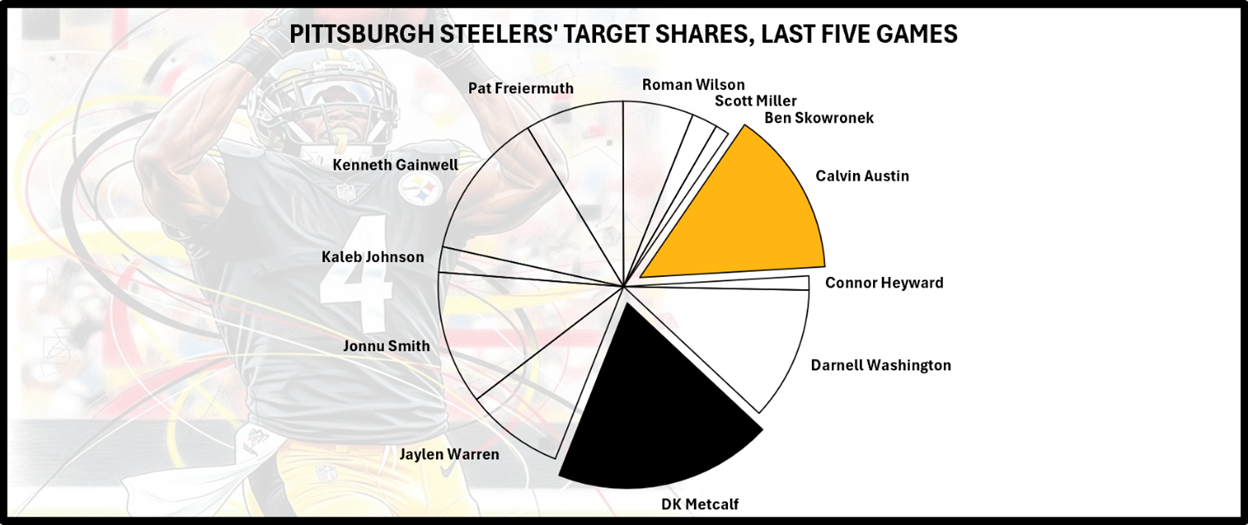
On low-pass volume, having no one with an exceptionally high target share is a problem for fantasy. Metcalf has 49 targets (T-34th), which is WR3 territory.
Like Rodgers, Metcalf has relied upon inordinately high TD production. His 10.4% TD rate this season is the highest of his career. His career average is 7%.
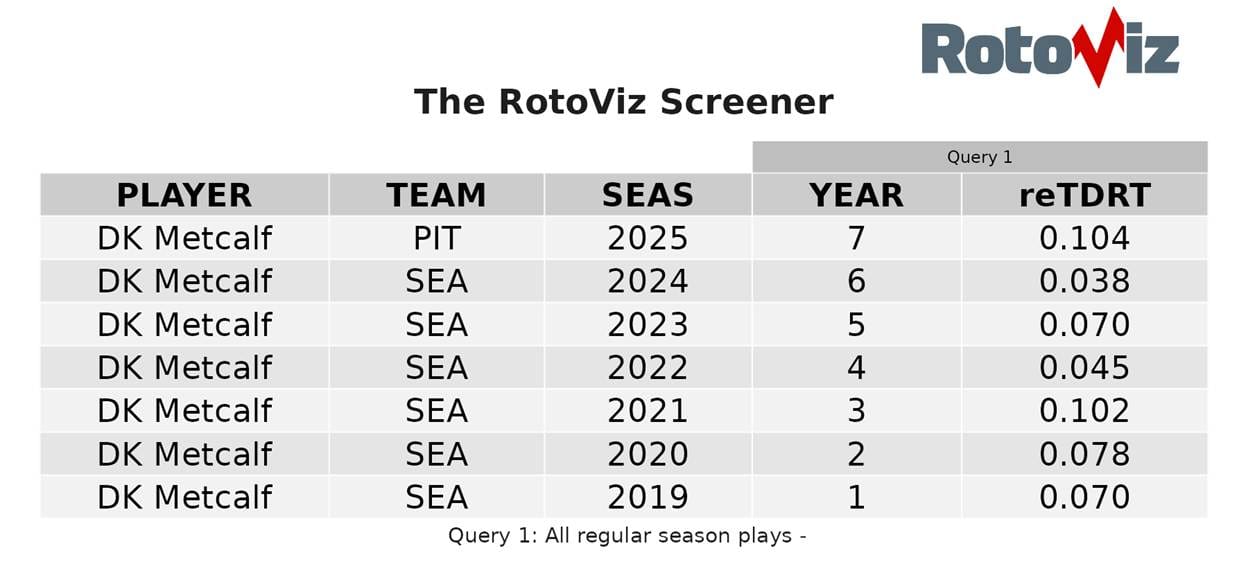
Metcalf is also a negative TD regression candidate, and if that TD production does level out, he’s going to become incredibly frustrating to trust. Metcalf has been boom or bust as it is, with three WR1 weeks and five as a WR3 or worse, with nothing in between.

No other Steelers’ WR can be trusted. As for TE, another long-standing narrative about Arthur Smith is that he frequently uses three TEs nearly interchangeably; this narrative has proven to be true in 2025, much to the chagrin of TE Jonnu Smith and TE Pat Freiermuth dynasty owners.
For the season, Smith leads the team in snaps and target share. TE Darnell Washington actually draws even with Smith in snap share, although he is used as a blocker far more.

Freiermuth has been able to pay off for fantasy GMs in two of the past three weeks, but no notable increase in usage produced these results. In the past three weeks, Smith and Freiermuth have each drawn 14% shares, while Washington has outsnapped both. These results were TD-driven, as Freiermuth combined for three scores in these two games.
And it isn’t as if Freiermuth gets ramped up for a specialty goal-line role, either. On the season, Freiermuth has two end zone targets—the same as Washington, Austin, and fourth TE Connor Heyward—and he is distantly behind Metcalf, who has seven. Belief in Freiermuth is fool’s gold, and he would be a sell candidate anywhere for anything, to anyone who believed in fantasy's overall TE5 from the last three weeks.
As previously mentioned, the Chargers excel in defensive efficiency metrics against the passing game; they are particularly strong in defensive success rate against the pass. Much of this is borne from their style, which is meant to keep everything out in front, limit big plays, and “bend, but don’t break.”
The Chargers run a 79.9% zone defense rate (5th) and use shell coverage 56.7% of the time (6th). They barely blitz at 19.1% (25th). Their priority coverage types are Cover 3, which they run 34.7% of the time (8th), and Cover 4, which they use 24.8% of the time (3rd).
Fantasy Points’ coverage matchup tool assigns a zero-based matchup grade to each pass-catcher based on their opponent’s use of specific types and rates of coverage and how that pass-catcher performs against them. Positive numbers indicate a favorable matchup and negative numbers indicate an unfavorable one.
Based on this, every significant matchup comes up negative for Pittsburgh this week except for Metcalf’s, which is barely in the black (+3.7%). Freiermuth (-14.9%) and Austin (-10.3%) have especially disadvantageous assignments based on types and rates of coverage.
PFF’s matchup tool is player-based, pitting the PFF ratings of individual players against each other for an expected number of plays based on historical tendencies and rating on a scale from great to poor.
In this model, every WR grades out as poor, and Freiermuth and Smith grade out as fair, along with Rodgers. According to PFF, the best receiving assignment actually goes to RB Jaylen Warren, whose matchup grades out as good.
We see this poor WR matchup bear out in raw fantasy data, as well. Against the Chargers, fantasy WRs have ranked 27th in the last five games, including games against Justin Jefferson, Jaylen Waddle, Deebo Samuel, and Michael Pittman.

If there’s room for any encouragement, it may be that, as we’ll get to on the Chargers’ side of the matchup, the Chargers could offset the lower play volume of the Steelers and drag them into a faster-paced shootout than we are accustomed to seeing, so the volume could easily go higher than we would presume from the statistics so far.
TE is pretty much a no-go in this offense anyway, but if there were any doubt, L.A. has held its opponents’ TEs to 28th in fantasy over their last five games. This is a sample that includes Ty Warren, Zach Ertz, and T.J. Hockenson.

The strength of the Pittsburgh offense has been its running game; they rank 12th in offensive EPA on rushes and 13th in offensive success rate on rushes.
This is also where the Chargers’ defense has been most vulnerable, ranking 18th in defensive EPA on rushes and 14th in defensive success rate on rushes.
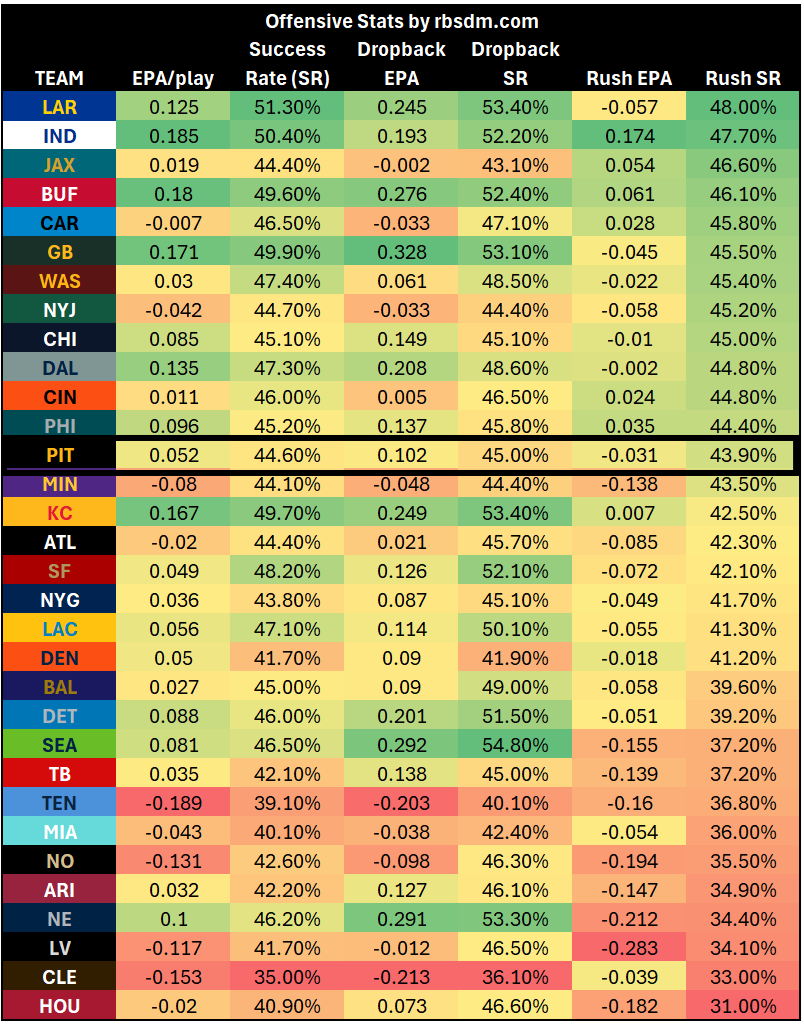
We often overlook the fact that the coaching staffs and analytics departments for these billion-dollar franchises also have access to advanced data, and they usually plan to prevent whatever they expect their opponents to exploit.
But in this case, it seems entirely possible that Pittsburgh would see running the football as the path of least resistance, and the Chargers may be willing to let them have that.
Despite the Steelers drafting RB Kaleb Johnson in the third round of the NFL draft, they’ve yet to involve him meaningfully. The support role, in fact, has gone to RB Kenneth Gainwell, who has a 13% target share and functions as the primary breather back and handcuff for the starter, Warren.
Warren has seized a healthy majority role in the Steelers’ offense, taking a 60% snap share, 63% of the team’s rush attempts (T-7th), and an 11% target share of his own. His 33% of team opportunities ranks 11th across all positions for fantasy.

Warren’s role has been good; his performances have been iffy. We should remember, of course, that the Steelers’ play volume is low, and this brings everybody’s opportunity to score fantasy points down. Warren has had better luck since returning from an injury that hampered him early, finishing as a top 12 RB twice in the last three weeks.
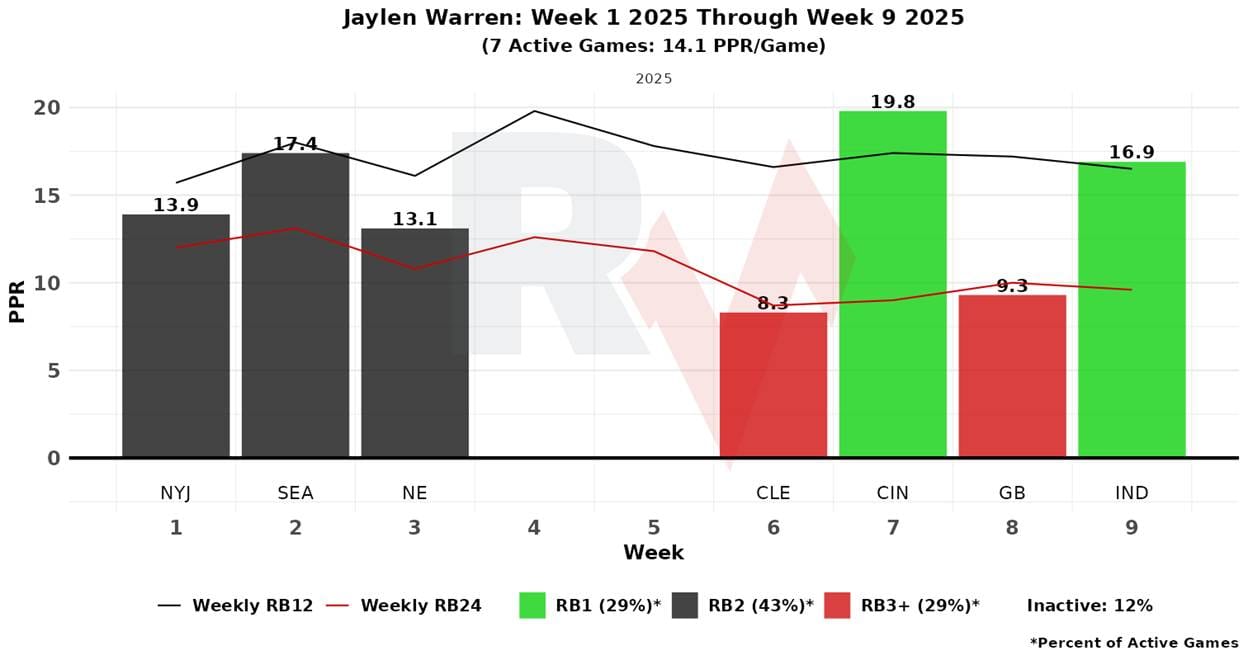
The Chargers’ defense has allowed the fifth-most PPR points to RBs in their last five games, a sample that includes Jonathan Taylor and De’Von Achane, but also Tony Pollard, Jordan Mason, and Jacory Croskey-Merritt.
Note the difference between their opponents’ expected points (EP) and fantasy points over expected (FPOE). This type of disparity would usually indicate that, despite success when they’ve utilized their RBs, teams are opting not to run. The most common reason multiple teams would make that same choice is that the Chargers are controlling the script and their opponents are chasing.
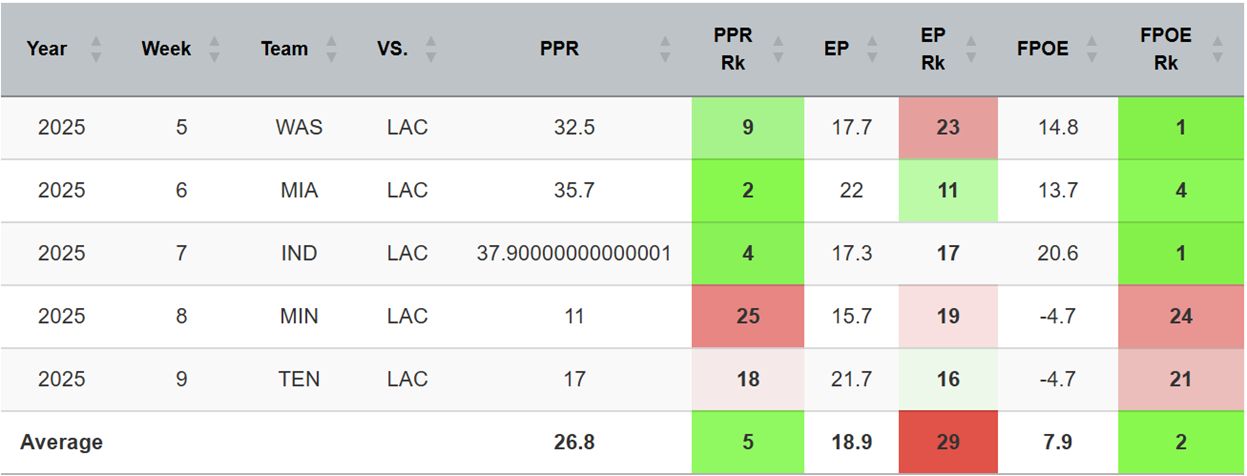
Again, if the Steelers opt to target the Chargers’ run defense from the outset, it appears to be a vulnerability they could successfully exploit. And generally speaking, an old-school coach like HC Mike Tomlin, with a run-based offense like Arthur Smith's, going on the road to play a formidable opponent, will commonly opt to try to shorten the clock and keep a high-powered offense like L.A.’s off the field. I expect this to be the strategy, and I anticipate the Chargers will be more or less okay with it.
